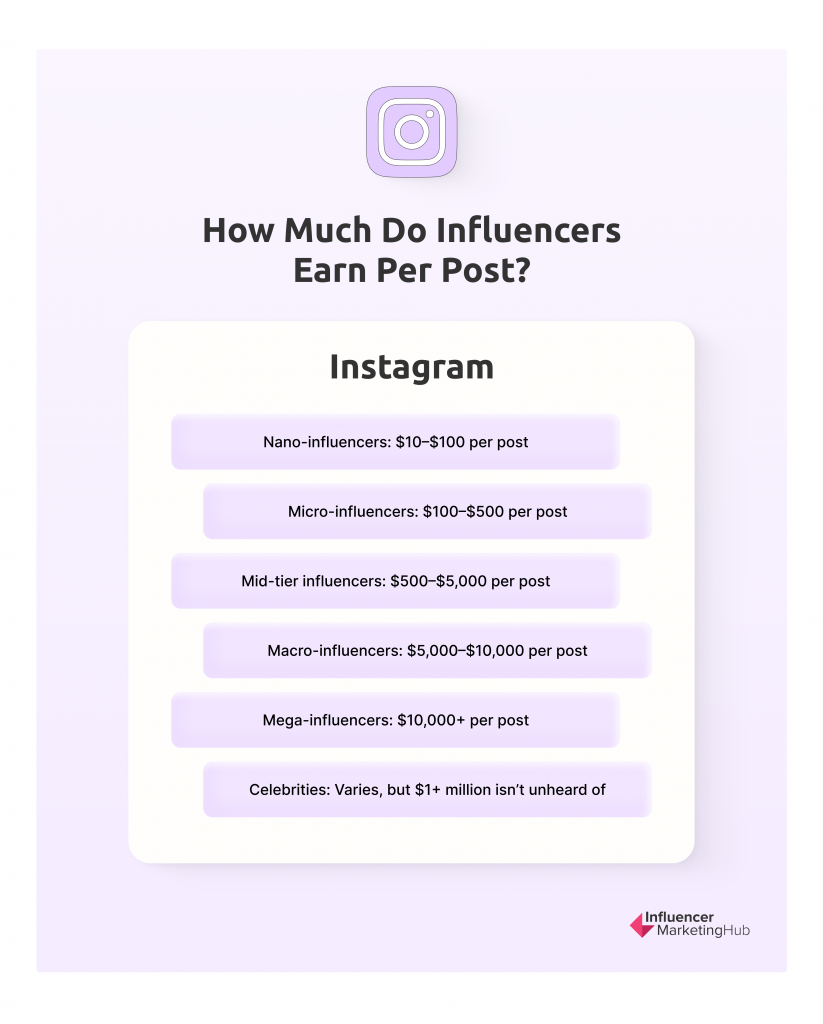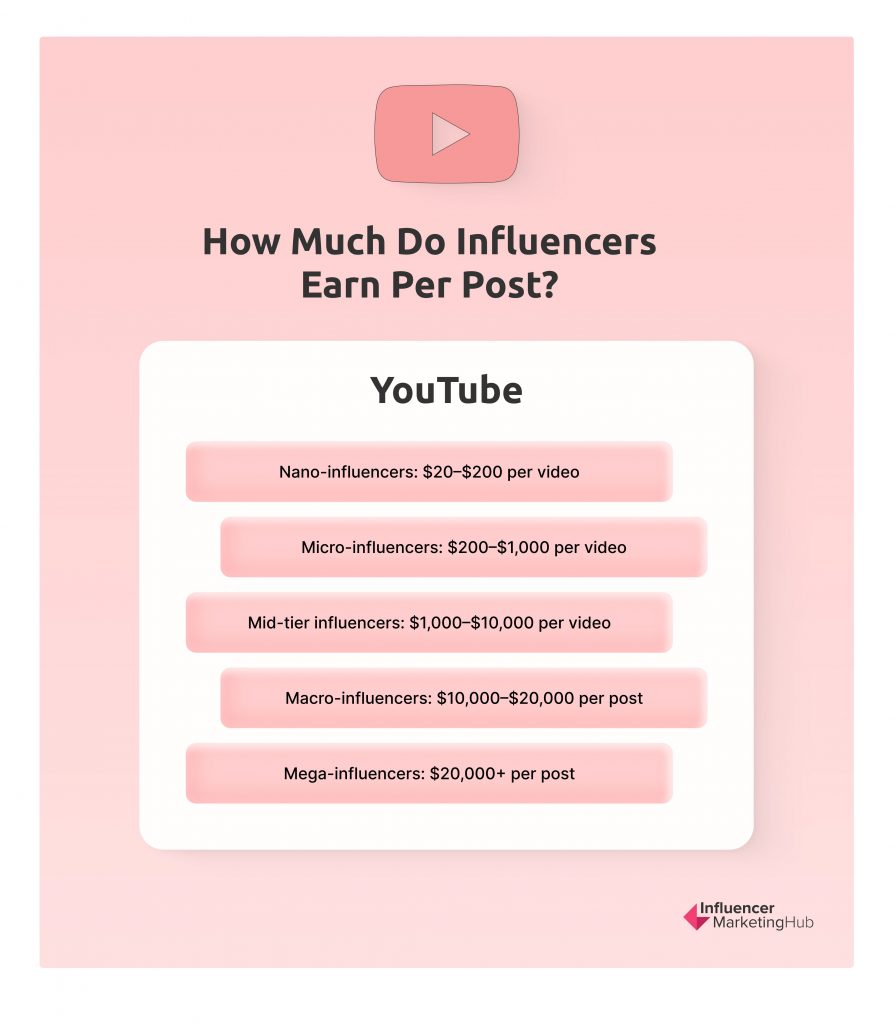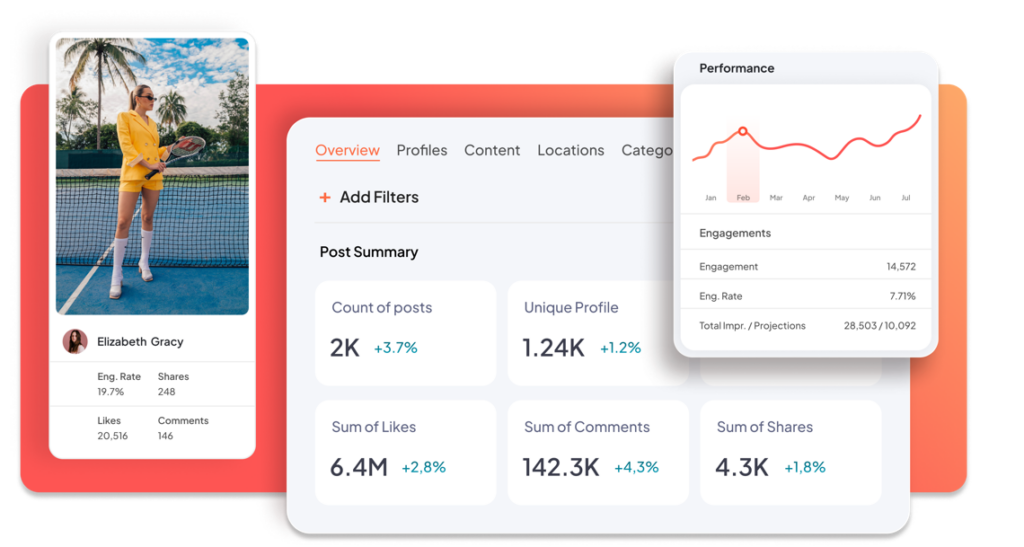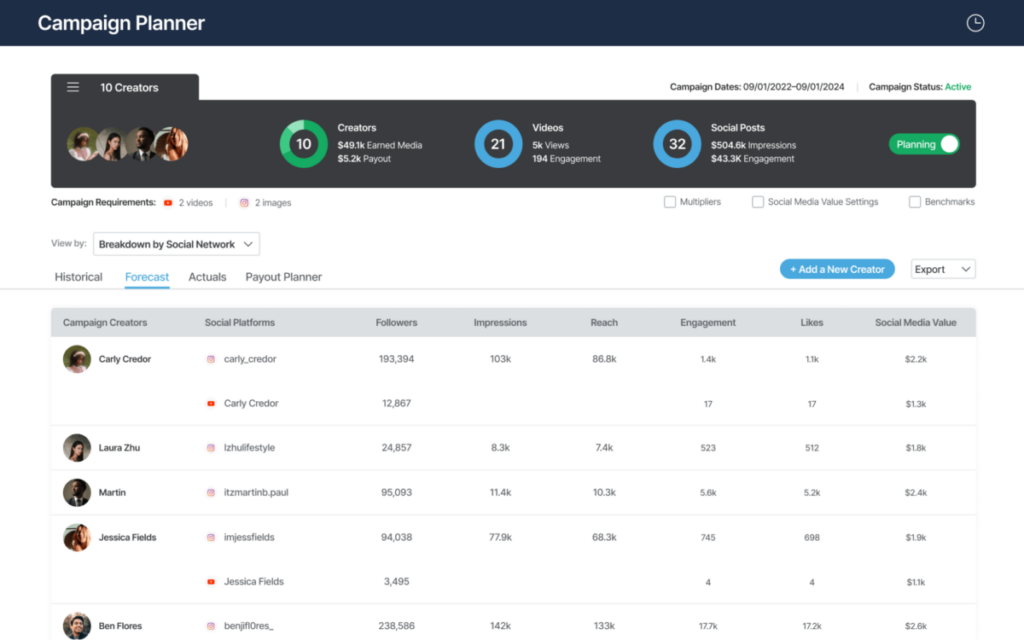If you’re planning an influencer marketing campaign, one of the first things you’ll consider is the cost. While you may choose influencers based on your budget, it’s important to gain some idea of how much influencers cost so you can set aside a realistic budget. This post gives you a detailed breakdown of influencer rates across various platforms and how to find an influencer based on your budget. Let’s get started.
- How Much Does Influencer Marketing Cost?
- How Much Do Influencers Earn Per Post?
- Which Social Media Platform Pays the Most?
- Types of Influencer Partnerships
- Finding the Best Influencers Within Your Budget
- How to Calculate Fair Influencer Rates: 8 Factors to Consider
- Find the Right Influencers at the Right Price
- Frequently Asked Questions
How Much Does Influencer Marketing Cost?
Before looking into influencer rates, you’ll need some idea of how much you can expect to spend on influencer marketing as a whole. You’ll be surprised to learn that you may be able to keep most of your influencer marketing spending within $10,000.
According to our State of Influencer Marketing Benchmark Report, 47.4% of respondents spent less than $10,000 on influencer marketing in 2024. There’s a slight increase from 2023 when 43% of marketers kept their influencer marketing spend within this limit. Meanwhile, 20.9% keep their spending between $10,000 and $50,000.
The rise in marketers spending less than $10,000 on influencer marketing could be attributed to newcomers in the scene experimenting with their influencer partnerships. Additionally, it could also be partly due to marketers working with smaller influencers, such as nano and micro-influencers, who tend to charge less than their more influential counterparts.
At the same time, the cost of influencer marketing could also be higher based on factors such as the type of campaign you’re running and the type of influencers you’re working with. For instance, there’s also been an increase in brands spending more than $500,000 on influencer marketing. While 11% of brands had a budget exceeding this amount in 2023, the number reached 14.5% in 2024.
How Much Do Influencers Earn Per Post?
While there are a number of ways to pay influencers, a common method is to pay them for each post. The exact rate will vary depending on factors such as the type of influencer and their following size, as well as the platform.
According to our State of Influencer Marketing report, the top five social media platforms for influencer marketing are:
- TikTok (68.8%)
- Instagram (46.7%)
- YouTube (33.1%)
- Facebook (27.5%)
- X (formerly Twitter) (9.9%)
We’ll break down the average influencer rates on each of these platforms in order of popularity.
TikTok Influencer Rates
While TikTok has grown significantly as a platform, influence rates aren’t yet well-defined or standardized. After looking at TikTok influencers who fall into these categories, we’ve included estimates.
TikTok has many influencers who aren’t necessarily celebrities, but who still have tens of millions of followers. These influencers can earn upwards of $10,000 per post. If you have your eye on a specific TikTok influencer just plug their username into our TikTok Money Calculator to see how much they average per post.
Instagram Influencer Rates
As Instagram held the top position for influencer marketing for a long time, influencer rates on the platform are slightly higher compared to TikTok and Twitter. Even mid-tier influencers can earn as much as $5,000 per post, although the actual rates may vary based on the following size and the content quality.
Want to check out a specific Instagram influencer to see if you can afford to bring them on? Or maybe you are an Instagram influencer wanting to get a better idea of what to charge. Use our Instagram Influencer Earnings Calculator!
YouTube Influencer Rates
Since YouTube influencers are creating videos, which are more time-consuming to make, they tend to charge more than most platforms. At the same time, it really depends on whether the partnership involves creating an entire video about your product or simply mentioning your brand as a sponsor.
Some YouTube influencers charge based on video views (charging $50–$100 per 1,000 views). We also have a YouTube Money Calculator to give you an idea of how much you could potentially earn.
Facebook Influencer Rates
Although Facebook’s popularity in influencer marketing has dwindled over the years, influencer rates on the platform are still comparatively high. Even micro-influencers may charge as high as $1,250 per Facebook post, depending on their following size and content.
X (Twitter) Influencer Rates
X (formerly Twitter) may be in the top five, but its usage is significantly lower compared to the other platforms, with less than 10% of brands using it. So, influencer rates on the platform are slightly lower. Nano-influencers on X may charge as low as $2 per post.
Which Social Media Platform Pays the Most?
The varying influencer rates across platforms can be attributed to factors such as the platform’s popularity and effectiveness as well as the type of content. With YouTube being a video platform, it’s one of the highest-paying platforms where mid-tier influencers can earn as much as $10,000 for a single video. Instagram is also another top-paying platform due to its popularity, while TikTok is slowly catching up.
Types of Influencer Partnerships
Now that we’ve talked a bit about influencer rates, you might be wondering what your influencer marketing dollars will get you. The cost of influencer marketing will also depend on the type of partnership you have.
In this section, we’ll walk you through the types of influencer partnerships available. Keep in mind that every influencer is different, uses different platforms, and engages with their audience through different formats. So check with your desired influencer to see if the influencer partnership you’re looking for is something they do.
Shoutouts
A shoutout happens when you pay a user to promote your brand or product on social media. They can be with or without a visual like video, images, or GIFs and can be used for any call to action (typically more sales, more followers for your brand, or more traffic to your website). Paid shoutouts are a classic influencer marketing tactic.
Giveaways
Giveaways are another popular influencer marketing tactic. They’re short-term, usually generate lots of interest, and provide value to both you as a brand and the influencer. Giveaways occur when a brand provides the influencer something of value that the influencer can then offer to their followers through a giveaway or contest. The result is usually increased brand awareness and leads.
Platform Takeovers
Takeovers are most popular on TikTok, Instagram, and Snapchat. This is when brands give an influencer access to their social media channel of choice. The influencer can then curate content for the brand and send their own followers to the brand’s account so they don’t miss what’s usually branded as “exclusive” content.
Affiliate Marketing
Affiliate marketing has been around for ages, hasn’t it? It works just as you’d expect for influencer marketing: an influencer promotes a brand’s product and gets a commission based on sales through the influencer’s platform. This is a bit skewed in favor of brands since the influencer only gets paid for actual sales.
Brands like using influencers for affiliate marketing because having pay tied to production like this tends to make influencers more effusive about your product.
Sponsored Content
Sponsored content is an influencer partnership you can leverage whether or not your brand has a lot of content ready to share. You can either create content for influencers to share or engage them to create and post content for your brand. Remember that it will cost you more if the influencer has to create the content, too.
Product Seeding or Gifts
Product seeding happens when brands send prominent influencers products and hope that the influencer will share something positive about it. While this partnership can work on nano-influencers or micro-influencers, influencers with larger followings are definitely going to expect brands to woo them a bit harder.
Brand Ambassador
The partnerships we mentioned above can be used for both short and long-term influencer partnerships. You may even get your chosen influencer to agree to discounted rates for a longer agreement. If you’re looking for a brand ambassador, however, you’re definitely looking for a long-term arrangement.
With these partnerships, influencers have probably been using your products for a while and are already excited about your brand. As a brand ambassador, influencers will consistently share videos, posts, images, and more about your brand and products for a lengthy period of time. Over time, they tend to become the “face” of your brand so choose your brand ambassadors wisely.
Influencer partnerships can range from shoutouts and giveaways to long-term brand ambassadorships, each offering unique benefits and engagement opportunities.
Finding the Best Influencers Within Your Budget
Finding the right influencer for your brand is a balancing act between what you can afford and how much they charge. As such, it really helps to think about your budget before you start looking for influencers. If you don’t know how much you can spend, it’s going to be a lot harder to figure out if the influencer you like is going to fit in your budget as long as you need them.
There are a few things to consider as you’re setting up your budget, namely your influencer marketing goals and whether or not you’ll be using influencer marketing tools or an influencer marketing agency. Additionally, it’s also important to evaluate the influencers carefully and the potential of your collaboration so you can avoid scammers or overpaying accounts with a huge following of bots.
Let’s walk you through the detailed steps to find influencers that fit your budget.
1. Understand Your Budget Constraints
Start with a clear understanding of how much you can afford to set aside for influencer marketing. Consider the typical cost of influencer marketing discussed earlier to set a budget for your campaign. Keep in mind your overall marketing goals so you can align your influencer marketing budget accordingly. For example, if you’re looking to drive sales, you’ll want to consider the cost of paying influencers a commission for the sales they help generate.
Don’t forget that your influencer marketing budget should cover both direct costs and indirect costs. For example, direct costs would include influencer fees whereas indirect costs would include content production costs. Additionally, your budget will need to cover influencer marketing platform fees, agency fees, and so on.
According to Delaney Trail, social media and influencer expert at Next PR,
“Understanding how much your team can allocate to pay influencers, both monetarily and with products, sets necessary parameters for the campaign.”
2. Define Your Goals
Having a clear goal for your campaign will help you understand what to look for in an influencer. It will also give you an idea of the types of campaigns you can run and how to align this with your budget.
“Every influencer campaign should start with a goal,”
stresses Delaney.
“This may be increasing sales, boosting brand awareness through social media, securing attendees for an upcoming event, or highlighting a product launch. Once your goal is identified, the strategy can be built around it,”
she explains.
Some common influencer marketing goals include:
- Building brand awareness
- Driving sales
- Increasing social media followers
- Generating leads
- Enhancing community engagement
3. Identify Your Target Audience
A crucial step is to determine who you want to reach with this specific campaign. You’ll then be able to figure out which influencers can reach your target audience and how they should get your message across to achieve your goal.
Look into your brand’s social media following to assess your audience demographics breakdown. Additionally, you’ll also want to consider the product or service and determine the types of people who need it. So you can build your campaign to specifically target the right people.
“Your target audience for the campaign should determine the influencers you choose to partner with,”
explains Delaney.
“An organic snack brand isn’t going to see the same engagement from a collaboration with a high-end lifestyle influencer as they will with a mommy vlogger, as their audiences have different interests and purchasing habits.”
“Consider creating audience personas, researching who your target audience follows and engages with to better understand what content resonates most with them,”
she advises.
4. Research and Identify Potential Influencers
Next, it’s time to conduct an influencer search so you can narrow down potential influencers within your budget. This is the most crucial step as it’s where you’ll start to really refine your search process.
Most influencer marketing platforms will let you conduct an influencer search based on categories and niches to ensure content alignment. Follower size is another common search field to ensure you’re working with influencers who have the kind of reach to help you meet your goal.
You’ll further fine-tune your search based on the engagement rate they’re able to generate, so you know you’re working with an influencer who can engage their audience.
In addition, you’ll want to look into a platform that lets you filter your search based on influencer rates. If you already have an idea of how much you’re willing to pay influencers, make sure to filter your search using this field.
Platforms like Tagger by Sprout Social will give you consolidated profile data of each influencer to simplify your search. The platform uses an Affinity Engine that leverages machine learning and audience psychographics to automatically match brands with influencers with a strong affinity. This simplifies your search process and helps you narrow down influencers who are perfectly aligned with your brand in terms of pricing and values.
5. Analyze Sponsored Post Engagement
Besides simply looking at how much an influencer charges, it’s crucial to make sure that you’re getting your money’s worth. So you’ll need to analyze the type of engagement they’re generating for their sponsored posts.
Sure, they may be getting tons of engagement for their organic posts. But if they’re not engaging their followers in their sponsored posts, you might want to reconsider your options. This is a sign that they’re unable to effectively promote the brand, possibly because they make the post come off as sales-y or ingenuine.
A manual search of the influencer’s feed will show you some sponsored posts so you can compare the engagements they receive against their organic posts. Or use an influencer marketing platform to identify the influencer’s most engaging posts. Then see if any of those posts include sponsored content.
An even simpler option is to use platforms like Influence.co, which lets you view the content that an influencer has created for other brands. This simplifies the process of identifying sponsored posts and analyzing their performance.
6. Assess Influencer Audience Demographics
Once you’ve narrowed down a few influencers whose rates are aligned with your budget, it’s time to further filter your list. A key step is to make sure the influencer’s audience demographics match your target audience.
Even if someone creates content in your niche, it doesn’t necessarily mean that they have influence over the specific types of people you want to reach. Similarly, even if they have a significant following, that doesn’t necessarily mean that their following is made up of people in the right demographic as your target audience.
Make the most of influencer marketing platforms that give you a comprehensive breakdown of an influencer’s audience demographics. Platforms like Creator.co offer deep insights into each creator’s audience demographics. You can view the breakdown of the ages, genders, countries, languages, and reachability of an influencer’s followers.
7. Detect and Avoid Bots
With influencer fraud being a major concern among brands working with influencers, another crucial step is to weed out creators who fake their influence. Otherwise, you could end up spending money on influencers who fail to generate real results. Sure, they may get engagements, but if those engagements mostly come from bots, you won’t be able to reach real consumers or drive sales.
You can look for signs such as sudden spikes in followers or inconsistent engagement rates. Generic or repetitive comments are another key sign that someone has bought engagement.
While manually vetting influencers for authenticity will pay off, it can be extremely time-consuming. Use platforms like Influencity that come with the capability to check an influencer’s follower quality. This platform will analyze each influencer’s followers and assess their quality. It will measure the percentage of followers that are “Nice” and the percentage that are “Doubtful,” so you can easily see which influencers possibly bought their influence.
8. Establish a Delivery Schedule
By now, you would’ve come up with a neat list of potential influencers who are perfectly aligned with your brand and budget. However, you’ll also need to make sure that these influencers are capable of meeting your needs within the necessary timeframe.
Set clear timelines for content delivery so your campaign can stay on track. Say you’re running the campaign for the month of September and expect four pieces of content from your influencers. In this case, you’ll want to make sure that each piece of content is ready to go live at the start of each week.
Make use of platforms like Sprout Social to create a content calendar. This helps you visualize your content deliverables so you can easily manage your content schedules. You can assign team members to follow up and make sure that the pieces are ready to go live by the expected due date.
9. Track Your Metrics
When it comes to finding influencers within your budget, it’s not enough to simply look at the rates to see if you can afford those influencers. You also need to see the results they’re generating to make sure that you’re getting good value for your money. At the end of the day, whatever you’re paying your influencers should be able to translate to real business results.
Start by measuring key metrics during the campaign to get real-time insights on how each influencer is performing. The key performance indicators (KPIs) to measure will vary depending on your goal. Some of the most common metrics to measure are:
- Impressions
- Reach
- Follower growth
- Engagements
- Conversion rates
- Clicks
- Earned media value
You can use a platform like CreatorIQ to get comprehensive performance metrics on your influencer marketing campaigns. The platform gives you a forecast of how each influencer is likely to perform and breaks down the actual performance metrics. So you can easily see which influencers are giving you a good value for your money.
10. Refine Your Strategy Over Time
Finally, you can use the insights from your campaign analytics to inform and optimize your strategy. Make sure you’re constantly monitoring these performance metrics to see how you can refine your strategy to maximize your influencer marketing impact.
This is particularly important if you’re running an ongoing influencer marketing campaign, such as brand ambassador campaigns. You’ll need to make sure you’re not overspending on influencers who aren’t generating real results for your business. At the same time, you’ll also want to make sure you’re investing in influencers who can add value to your strategy.
If you’re using the CreatorIQ platform, as suggested earlier, you can compare the forecasted performance against the actuals to see if an influencer is underperforming. Then consider removing them from future campaigns or providing feedback to help them yield better results. Similarly, make a list of your favorite influencers so you can easily activate them again for future campaigns instead of performing a new influencer search all over again.
How to Calculate Fair Influencer Rates: 8 Factors to Consider
There are a number of factors that can impact how much an influencer charges for their services and it’s rare to find an influencer who charges a flat rate.
Influencer marketing is a legitimate business and influencers set their rates based on what brands will pay. While our list doesn’t cover everything that goes into determining how much an influencer might charge, these are the things you can count on to have an impact:
- The influencer’s reach and engagement
- The channel they use
- How many posts you want and if they include things like images, videos, and audio
- How much effort it will require from the influencer
- Where the ad will be promoted/cross-posted
- Agency fees (if the influencer is with an influencer marketing agency)
Let’s take a closer look at these parameters and more so you can get a better idea of what it is you’re paying for.
1. Social Media Platform
Based on the platform-wise breakdown of influencer rates, you can get an idea that influencers will charge a different price according to the social media platform. This is largely owing to the popularity of the platform for the niche you’re targeting and the value they can generate via each platform.
For instance, collaborating with fitness influencers on YouTube may be cheaper than Instagram or TikTok. However, the latter two platforms are generally more popular for this type of content. So you’ll likely see higher engagements for this industry, generating more value for your campaign in the long run.
According to Lucas Botzen, HR Expert & CEO at Rivermate,
“Influencer rates across platforms differ drastically due to the huge differences in both reach and engagement. Visual channels like Instagram and YouTube tend to have higher average rates because they have audience members who stick around for a little while.”
“However, put together, TikTok and Twitter are a rather cost-effective channel—namely, for businesses targeting younger demographics or shooting for virality,”
Lucas explains.
“From my experience, by far the platform that stands out as particularly cost-effective is TikTok, with high engagement at lower costs compared to traditional platforms like Instagram.”
2. Influencer Reach
Reach is how many people the influencer has access to from their platform. This is largely based on how many followers or subscribers the influencer has and how many they have the potential to reach. More often than not, the more followers an influencer has, the higher their rates are going to be.
Influencers fall into certain categories based on their reach:
- Nano-influencers: 1,000–10,000 followers
- Micro-influencers: 10,000–50,000 followers
- Mid-tier influencers: 50,000–500,000 followers
- Macro-influencers: 500,000–1,000,000 followers
- Mega-influencers: 1,000,000+ followers
You might see variations of this breakdown (some marketers consider a micro-influencer to start at 1,000 and don’t label nano-influencers in this way).
3. Follower Engagement
You’ll find that influencer rates fluctuate based on how much engagement an influencer generates on their organic vs. sponsored content. You may think that influencers with more followers are going to get better engagement rates, but that’s not usually the case.
Look closely at how much an influencer’s audience really engages and interacts with their content. The more engaged their followers are, the better for your message.
4. Industry or Specialization
Obviously, you’ll want to find an influencer who specializes in the industry you’re in. Would you trust a fitness influencer who suddenly started talking about financial services, especially if they’ve never so much as hinted that finance was an interest of theirs before?
Popular niches (beauty and fitness, for example) are going to have more influencers available and the pricing will likely be lower than niches with fewer available influencers.
You can also take a look at the industries favored by an influencer’s audience to make sure that it makes sense to hire them for your brand.
“In this context, industry specialization and niche have a great impact on influencer rates,”
explains Lucas Botzen.
“Fashion, beauty, and technology are usually part of the more highly paid niches, driven by high demand and an immensely powerful capacity to make people buy when a credible influencer is involved.”
“On the other end of the scale, niches like DIY crafts or very narrow interests in hobbies might have lower rates due to smaller sizes of audiences and therefore weaker commercial demand,”
he elaborates.
“This niche in fashion often gives very high engagement, hence valuably lower in its costs, as has been proven by a successful DIY campaign that we have run that returned fine ROI for little investment.”
5. Type of Content
The type of content you’re asking an influencer to create will also have an impact on the pricing. This is because influencers will need to spend time, energy, and resources to create the content and different types of content require different things.
This includes considerations like how much content the influencer will need to create and whether they or you will be providing the necessary resources. The more effort it takes to create the content you’re asking for, the more you can expect it to cost.
6. Influencer Demand
If you’re asking for a seasonal social media campaign, you can expect that it will come with a premium price tag. This is standard economics: high demand leads to higher rates. You can also run into this issue outside of seasonal campaigns if you’re interested in an influencer that’s particularly popular.
7. Usage Rights
If you plan to repurpose an influencer’s content, be sure to discuss that with them ahead of time and outline the terms in the influencer contract. Some influencers will charge more for content that’s going to be reused. Think of each use as an individual product—once you’ve used the product up by having the influencer post a video about your brand to their Instagram account, you have no product left to use in your Facebook ads.
8. Exclusivity
Influencers make their money by promoting different businesses. It’s possible that you might choose an influencer that your competitor wants to use, too. In this situation, you might want to ask the influencer to sign a non-compete agreement or exclusivity clause with their influencer contract that will prohibit them from promoting a competitor for a certain period of time.
But, you’d better be prepared to pay. Quite a bit, too, since you’re essentially asking them to give up other potential income.
Find the Right Influencers at the Right Price
The process of finding the right influencers for your brand doesn’t just end with looking at their niche and engagements. You’ll need to make sure the influencer’s rate aligns with your budget so you’re not spending more than you can afford. Use the detailed guide we shared above to narrow down the best influencers within your budget so you can get great value for your money.
Frequently Asked Questions
How do you determine your influencer campaign budget?
You need to decide whether you are comfortable paying on an affiliate basis, fixed payment, hourly rate, licensing deal, or a combination of above. Likewise, you can also do gifting as a form of payment.
What do you need before you contact a prospective influencer?
Before you contact a prospective influencer, you need to understand your business model and discuss what collaboration would best benefit your business.


















